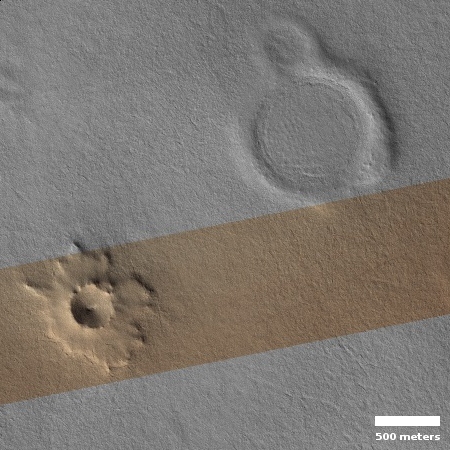The damp southern latitudes of Mars
Cool image time! The image on the right, cropped to post here, was part of the monthly image release from the high resolution camera on Mars Reconnaissance Orbiter (MRO). The release came with no caption, and was merely titled Aonia Terra, indicating that it was part of the vast cratered region ranging from 30 to 81 degrees latitude south of Valles Marineris.
These craters are at the high latitude of 73 degrees, so they are relatively close to the south pole. Based on what I have recently learned about the Martian poles, the higher the latitude the more water you will find saturated in the ground. In many ways one could refer to this ground as a kind of permafrost.
The lander Phoenix landed at about 68 degrees north latitude, slighter farther from the north pole, and was able to find water by merely scraping off a few inches of ground.
Thus, we should not be surprised by the muddy look of these craters. Their bolides landed on ground that was likely saturated with water, and went splat when they hit.
The scientific puzzle is why one crater seems to sit above the general surface, as if the ground resisted the impact, while the other seems to be mostly sunken, as if the ground was so soft that when the bolide hit, it sunk as if it landed on quicksand, leaving only a vague trace of an impact crater.
Don’t ask me for an explanation. I only work here.
On Christmas Eve 1968 three Americans became the first humans to visit another world. What they did to celebrate was unexpected and profound, and will be remembered throughout all human history. Genesis: the Story of Apollo 8, Robert Zimmerman's classic history of humanity's first journey to another world, tells that story, and it is now available as both an ebook and an audiobook, both with a foreword by Valerie Anders and a new introduction by Robert Zimmerman.
The print edition can be purchased at Amazon or from any other book seller. If you want an autographed copy the price is $60 for the hardback and $45 for the paperback, plus $8 shipping for each. Go here for purchasing details. The ebook is available everywhere for $5.99 (before discount) at amazon, or direct from my ebook publisher, ebookit. If you buy it from ebookit you don't support the big tech companies and the author gets a bigger cut much sooner.
The audiobook is also available at all these vendors, and is also free with a 30-day trial membership to Audible.
"Not simply about one mission, [Genesis] is also the history of America's quest for the moon... Zimmerman has done a masterful job of tying disparate events together into a solid account of one of America's greatest human triumphs."--San Antonio Express-News
Cool image time! The image on the right, cropped to post here, was part of the monthly image release from the high resolution camera on Mars Reconnaissance Orbiter (MRO). The release came with no caption, and was merely titled Aonia Terra, indicating that it was part of the vast cratered region ranging from 30 to 81 degrees latitude south of Valles Marineris.
These craters are at the high latitude of 73 degrees, so they are relatively close to the south pole. Based on what I have recently learned about the Martian poles, the higher the latitude the more water you will find saturated in the ground. In many ways one could refer to this ground as a kind of permafrost.
The lander Phoenix landed at about 68 degrees north latitude, slighter farther from the north pole, and was able to find water by merely scraping off a few inches of ground.
Thus, we should not be surprised by the muddy look of these craters. Their bolides landed on ground that was likely saturated with water, and went splat when they hit.
The scientific puzzle is why one crater seems to sit above the general surface, as if the ground resisted the impact, while the other seems to be mostly sunken, as if the ground was so soft that when the bolide hit, it sunk as if it landed on quicksand, leaving only a vague trace of an impact crater.
Don’t ask me for an explanation. I only work here.
On Christmas Eve 1968 three Americans became the first humans to visit another world. What they did to celebrate was unexpected and profound, and will be remembered throughout all human history. Genesis: the Story of Apollo 8, Robert Zimmerman's classic history of humanity's first journey to another world, tells that story, and it is now available as both an ebook and an audiobook, both with a foreword by Valerie Anders and a new introduction by Robert Zimmerman.
The print edition can be purchased at Amazon or from any other book seller. If you want an autographed copy the price is $60 for the hardback and $45 for the paperback, plus $8 shipping for each. Go here for purchasing details. The ebook is available everywhere for $5.99 (before discount) at amazon, or direct from my ebook publisher, ebookit. If you buy it from ebookit you don't support the big tech companies and the author gets a bigger cut much sooner.
The audiobook is also available at all these vendors, and is also free with a 30-day trial membership to Audible.
"Not simply about one mission, [Genesis] is also the history of America's quest for the moon... Zimmerman has done a masterful job of tying disparate events together into a solid account of one of America's greatest human triumphs."--San Antonio Express-News



The crater on the right looks like a figure 8 repel device.
The one on the left, an impact triggering mud volcanos?